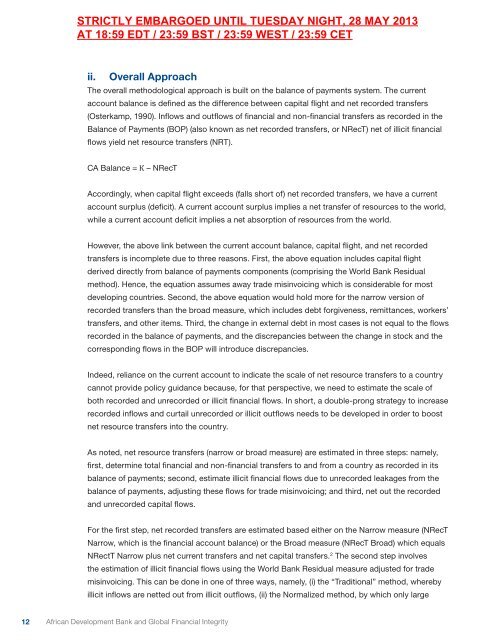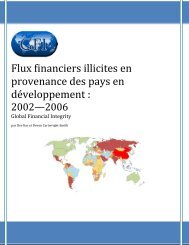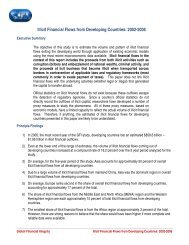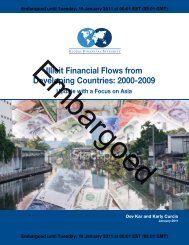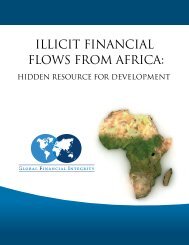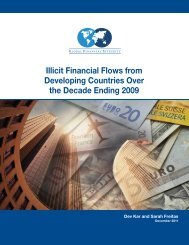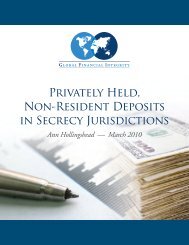Illicit Financial Flows
Illicit Financial Flows and the Problem of Net Resource Transfers ...
Illicit Financial Flows and the Problem of Net Resource Transfers ...
Create successful ePaper yourself
Turn your PDF publications into a flip-book with our unique Google optimized e-Paper software.
STRICTLY EMBARGOED UNTIL TUESDAY NIGHT, 28 MAY 2013<br />
AT 18:59 EDT / 23:59 BST / 23:59 WEST / 23:59 CET<br />
ii. Overall Approach<br />
The overall methodological approach is built on the balance of payments system. The current<br />
account balance is defined as the difference between capital flight and net recorded transfers<br />
(Osterkamp, 1990). Inflows and outflows of financial and non-financial transfers as recorded in the<br />
Balance of Payments (BOP) (also known as net recorded transfers, or NRecT) net of illicit financial<br />
flows yield net resource transfers (NRT).<br />
CA Balance = К – NRecT<br />
Accordingly, when capital flight exceeds (falls short of) net recorded transfers, we have a current<br />
account surplus (deficit). A current account surplus implies a net transfer of resources to the world,<br />
while a current account deficit implies a net absorption of resources from the world.<br />
However, the above link between the current account balance, capital flight, and net recorded<br />
transfers is incomplete due to three reasons. First, the above equation includes capital flight<br />
derived directly from balance of payments components (comprising the World Bank Residual<br />
method). Hence, the equation assumes away trade misinvoicing which is considerable for most<br />
developing countries. Second, the above equation would hold more for the narrow version of<br />
recorded transfers than the broad measure, which includes debt forgiveness, remittances, workers’<br />
transfers, and other items. Third, the change in external debt in most cases is not equal to the flows<br />
recorded in the balance of payments, and the discrepancies between the change in stock and the<br />
corresponding flows in the BOP will introduce discrepancies.<br />
Indeed, reliance on the current account to indicate the scale of net resource transfers to a country<br />
cannot provide policy guidance because, for that perspective, we need to estimate the scale of<br />
both recorded and unrecorded or illicit financial flows. In short, a double-prong strategy to increase<br />
recorded inflows and curtail unrecorded or illicit outflows needs to be developed in order to boost<br />
net resource transfers into the country.<br />
As noted, net resource transfers (narrow or broad measure) are estimated in three steps: namely,<br />
first, determine total financial and non-financial transfers to and from a country as recorded in its<br />
balance of payments; second, estimate illicit financial flows due to unrecorded leakages from the<br />
balance of payments, adjusting these flows for trade misinvoicing; and third, net out the recorded<br />
and unrecorded capital flows.<br />
For the first step, net recorded transfers are estimated based either on the Narrow measure (NRecT<br />
Narrow, which is the financial account balance) or the Broad measure (NRecT Broad) which equals<br />
NRectT Narrow plus net current transfers and net capital transfers. 2 The second step involves<br />
the estimation of illicit financial flows using the World Bank Residual measure adjusted for trade<br />
misinvoicing. This can be done in one of three ways, namely, (i) the “Traditional” method, whereby<br />
illicit inflows are netted out from illicit outflows, (ii) the Normalized method, by which only large<br />
12 African Development Bank and Global <strong>Financial</strong> Integrity


